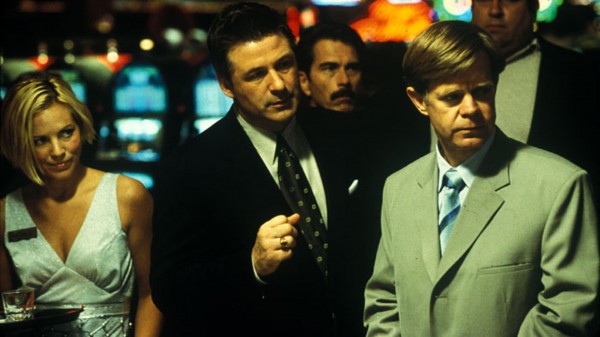
“I’m on a roll, I’m on a roll, this time. I feel my luck could change.” Just as it seemed that I’d have to settle into Valentine’s Day weekend with the cloying miasma of Love Actually still wafting in the air, along came Wayne Kramer’s The Cooler (by way of my local Blockbuster.) Stacked with quality performances by William H. Macy, Maria Bello, Alec Baldwin, Paul Sorvino, and Ron Livingston, The Cooler is an enchanting magical realist tale about the transformative power of love that I found passionate, poignant, and poetic (and not in the Vogon sense.) I thought it managed to capture that first, giddy and glorious flush of a new romance in spades.
The film begins with Bernie (Macy), a guy beat down so low by life he makes Jerry Lundegaard seem like Tony Robbins, ambling around the once-fabulous Shangri-La casino, bestowing bad mojo like a benediction upon any unfortunate gambler in his wake. Y’see, Bernie is such a hard luck case that he infects everyone around him with his awful fortune, and has thus been hired as a “cooler” by Old Vegas mob boss Shelley Kaplow (Baldwin, well-deserving of his Supporting Actor nomination.) But, when Bernie encounters cocktail waitress and amateur astrologist Natalie (Bello), Cupid works some mojo of his own, and soon enough a revitalized, invincible Bernie inexplicably has the Midas Touch, which may not sit well with his employers…
True, you can guess where this is basically going from the opening moments. The Cooler is ultimately a brief genre exercise in noir romance – It’s not reinventing the wheel. But the wry script takes a few jags I wasn’t expecting, and Kramer, Macy, and Bello succeed in fashioning two lovebirds who veer from playful to amorous to desperate for each other in a way that belies the cookie cutter courtship of so many other films. (And while it at first seems that The Cooler has a Sideways problem, it doesn’t, for spoilerish reasons which will be evident if you see the movie.) In sum, if you can stomach the occasional burst of Old Vegas-style mob brutality (usually at the hands of Baldwin), The Cooler is a testament to the notion that even perennial losers can sometimes catch a lucky break, and a touching character-driven romance well worth checking out.
